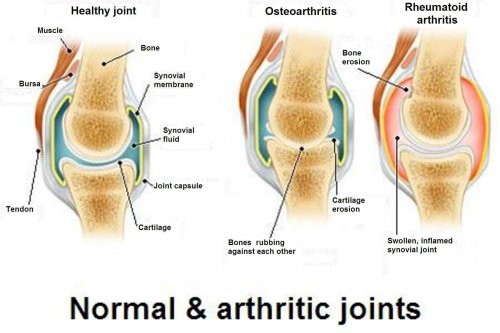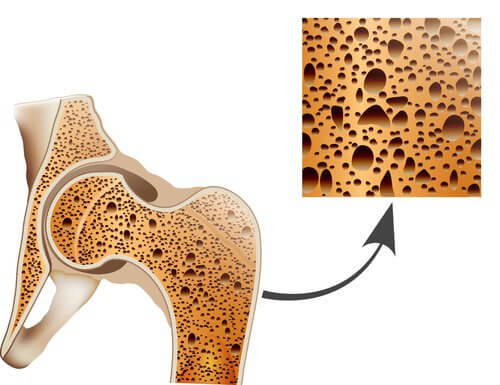Osteoarthritis, Osteoporosis and Arthritis: What Are the Differences?


Written and verified by psychologist Valeria Sabater
Arthritis, osteoarthritis, and osteoporosis are not the same thing. Anyone who suffers from any of them already knows this well. However, it’s easy for others to confuse the terms. All of them are related to your bones, but each condition has specific causes and ways to treat them.
However, all of them are very common among today’s population. One thing that arthritis, osteoarthritis, and osteoporosis have in common is that they affect women to a greater extent than men. Therefore, it’s key for women to have constant check-ups to detect them in time. Find out more here.
First of all, all three are degenerative diseases without treatment. This means that there is no definite solution to get rid of them. However, there are medications that help you deal with the symptoms. In addition, there are therapies to help reduce inflammation, numbness, or pain.
In today’s article, we want to explain the difference between these three conditions so that you’ll understand them a little more. Identifying what is the condition is the first step to know how to treat it properly and ease your pain.
Osteoarthritis, the most common
Among the rheumatic diseases, osteoarthritis is the most common one. Its main characteristic is that it degenerates the cartilage in your joints. This leads to a lot of discomfort and pain.
Also, remember that cartilage is a tissue that covers the ends of your bones. It helps them to move without touching each other. When your cartilage loses its strength or quality, this can cause friction, pain, and swelling.
Osteoarthritis is very common in the hips, knees, and ankles (any place that supports the weight of the body). Unfortunately, as we mentioned before, there is no medication for this condition. You can slow down the progression of the disease, but you cannot stop it.
If you don’t have osteoarthritis and want to prevent it, it’s a good idea to practice gentle sports and avoid gaining weight. You should also have a balanced diet that’s rich in vitamin C, as it helps produce collagen. Then, with more collagen, your cartilage will be healthier and stronger.
Nevertheless, if osteoarthritis is already a part of your life, you have to be sure that you never miss a dose of vitamin C or minerals like calcium and magnesium, silicon, and sulfur, among others. Make sure to stay in touch with your doctor to stop the condition from advancing.
Read also: How to Prevent Cartilage Pain
Arthritis, not a matter of aging

Believe it or not, arthritis doesn’t develop over the years. In addition, just because you grow up doesn’t mean you’re going to develop it. Therefore, it’s important to stay alert to pain related to your bones.
Although there are many different kinds of arthritis, this disease can appear in children and in people who lead an active lifestyle, athletes, and people who perform intense activities at work. Because of that, it’s important to check your bone health constantly, as you might develop arthritis despite having a healthy lifestyle.
Arthritis can have a variety of origins:
- Immune system: Your immune system may attack your synovial membranes (the layer of tissue that lines the insides of your joints). In this case, it’s crucial for your doctor to identify the disease that might be hurting your bones.
- Post-traumatic causes: This happens when you’ve had an accident or if you are constantly sitting down or stressing your bones.
- Also, a build up of crystals from uric acid can lead to arthritis. To prevent this, make sure to follow a healthy diet.
Arthritis tends to occur with continuous and intense pain. While people with osteoarthritis will find relief when they are at rest, arthritis tends to have pain that doesn’t go away.
To prevent arthritis, follow a diet that’s rich in calcium, omega-3 fatty acids and omega-6 fatty acids. In addition, get moderate physical activity. Also spend time outside, getting enough sunlight to synthesize vitamin D. These small changes will allow you to develop healthy habits, that will, in turn, nurture your body and help you feel better.
You might also like: 10 Home Remedies for Excess Uric Acid
Osteoporosis, very common among women

Osteoporosis is a systemic, chronic disease that affects the bones. You might spend many years without knowing you have it until you suddenly suffer from a fracture for seemingly no reason. This means your bones have been losing strength for some time.
Your bones, just like other tissues, are constantly renewing themselves. This lets them stay strong and healthy. However, at times, this process might stop happening. For example, with menopause, your bones can become weaker and weaker. Also, with age, this process becomes slower and less efficient.
In other words, with time you stop forming new tissue that is strong. Over time, you lose bone density, which increases your risk of fractures. With osteoporosis, the bones become more porous, especially around the wrists, hips, and vertebrae. This makes them much weaker and prone to injuries.
To treat this disease, supplements that are rich in calcium and vitamin C will help you. If your doctor recommends it, bisphosphonates are very helpful for allowing calcium to penetrate into the bone tissue and help it regenerate.
A curious fact is that in recent years, some medications are on the market that are made with monoclonal antibodies. These are applied through pinpricks and can remarkably improve the quality of life in patients with this condition.
Finally, even though these are some of the most evident differences among these bone illnesses, if you have any discomfort at all, don’t hesitate to visit your doctor. They will make sure to identify what is going on and give you tips on how to deal with it.
All cited sources were thoroughly reviewed by our team to ensure their quality, reliability, currency, and validity. The bibliography of this article was considered reliable and of academic or scientific accuracy.
- Acosta Hernández Reinaldo R.. ¿Artritis o artrosis?. Rev Cubana Med Gen Integr [Internet]. 2008 Sep [citado 2018 Dic 12] ; 24( 3 ). Disponible en: http://scielo.sld.cu/scielo.php?script=sci_arttext&pid=S0864-21252008000300001&lng=es
- Hermoso de Mendoza M.T.. Clasificación de la osteoporosis: Factores de riesgo. Clínica y diagnóstico diferencial. Anales Sis San Navarra [Internet]. 2003 [citado 2018 Dic 13] ; 26( Suppl 3 ): 29-52. Disponible en: http://scielo.isciii.es/scielo.php?script=sci_arttext&pid=S1137-66272003000600004&lng=es.
- Noa Puig Miriam, Más Ferreiro Rosa, Mendoza Castaño Sarahí, Valle Clara Maikel. Fisiopatología, tratamiento y modelos experimentales de artritis reumatoide. Rev Cubana Farm [Internet]. 2011 Jun [citado 2018 Dic 12] ; 45( 2 ): 297-308. Disponible en: http://scielo.sld.cu/scielo.php?script=sci_arttext&pid=S0034-75152011000200014&lng=es.
This text is provided for informational purposes only and does not replace consultation with a professional. If in doubt, consult your specialist.








